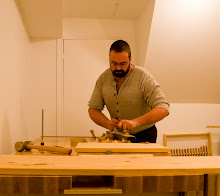I can understand the initial scepticism, as the design is quite different from a traditional western dovetail saw. See below, in this image from their website, used without permission, but I'm willing to risk it since I've been a customer for over 20 years.
 Anyway, that's not really what a traditional dovetail saw looks like. Not at first glance. If you spend a bit of time looking at it then it actually gets more reasonable. It's still a pistol-grip backed dovetail saw with 14 tpi. Pretty normal, that. What's not normal is the material the back (or spine) is made from, and the way the tote (handle) is mounted to the saw.
Anyway, that's not really what a traditional dovetail saw looks like. Not at first glance. If you spend a bit of time looking at it then it actually gets more reasonable. It's still a pistol-grip backed dovetail saw with 14 tpi. Pretty normal, that. What's not normal is the material the back (or spine) is made from, and the way the tote (handle) is mounted to the saw.Instead of a traditional brass back the saw has an injection molded composite back which Veritas says has glass fibres added for strength and rigidity, and stainless steel powder added to increase weight.
Instead of having a large tote that bolts right onto the blade, it actually bolts onto the spine. A traditional saw uses the blade as the primary structural element - the brass back attatches to the blade, and the tote attatches to the blade. This saw uses the spine as the primary structural element. The blade and tote attach to the spine.
Injection molding is a very efficient manufacturing method for producing parts with consistent tolerances, so if the molds are made properly the saws will be very consistent with few quality problems in terms of misaligned blades, etc.
This efficiency has left the saw with a very attractive price of only $65 Canadian. This puts it in the price range of decent Japanese dovetail saws.
I have several reasons for being fond of the manufacturing process... I used to build the type of grinders used to make the stainless powder for the spine, and I now work in the plastics industry.
So will I buy one of these saws?
Probably not. I'm quite happy with my traditional saws, but they cost a lot more than $65 each, hand-made by Ed Paik at Medallion Toolworks in Oakville. The hand-made approach allowed me to get a custom saw that is 2" longer than traditional, and almost an inch deeper. I wanted a big saw, and I was able to get that from Ed. I wouldn't be able to get that from Lee Valley Tools, and that's just fine because I'm not their target buyer.
I think the target buyer for this saw is a power-tool user or new hand-tool user who wants to try dovetails or other hand joinery, but doesn't want to have to pay a great deal for a new, premium-make dovetail saw, and doesn't want to buy a garage-sale reject and learn how to fettle it, sharpen it, and generally make it work. You might have seen my entry about this process in "New Life for Old Saw". Keep in mind that in that entry all I did was fix the teeth. I didn't bother cleaning the rust off of the blade, etc. Anyway, fixing such a saw is by far the cheapest way to get a decent dovetail saw, but saw sharpening is a new skill to learn, and not everybody has a saw vise, so then you'd have to buy or make one of those as well. So fixing an old saw isn't for everyone. Buying a new saw is fraught with peril because the known good brands of western saws are expensive. This might lead some to pick a Japanese saw on price alone. Now there is a western alternative in a similar price range, and I think that's great.
Those who have tried the saw claim that it works very well.
